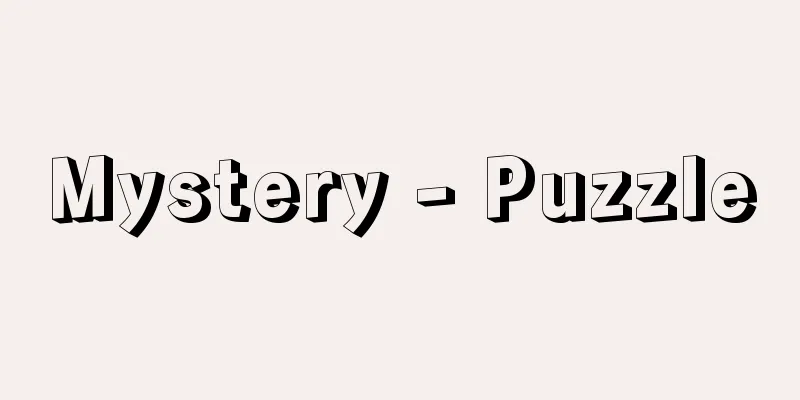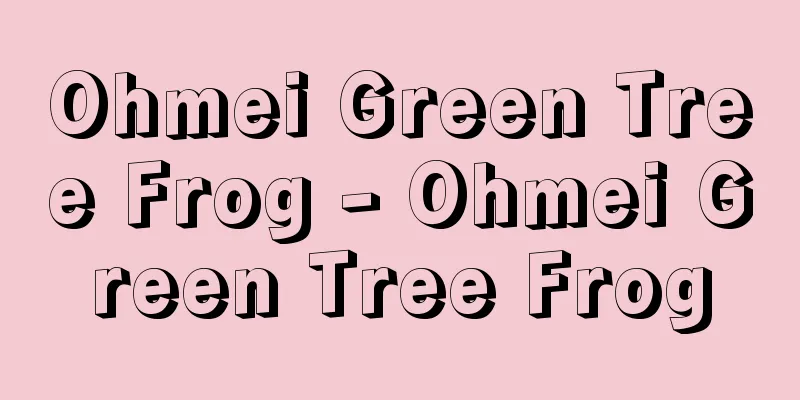Mystery - Puzzle

|
A type of word game. Depending on the region, it is also called "nazo nazo" or "najo najo". The word "nazo" (what) has become a noun, and it is a game in which a question is asked that includes other meanings in a word, and the player tries to explain the meaning. It can also be said to be a form of asking someone a question by adding the word "nazo" to the end of a proverb that is difficult to understand. As with old tales, certain conventions are followed, and the game is played by reciting the set phrase "nazo nazo naani" (what is a riddle), or by two people playing a dialogue. Playing with riddles is called "nazo wo tateru" (making a riddle) or "nazokake" (a riddle). There are many examples of riddles around the world, but one famous philosophical riddle is said to have been asked by the Sphinx in ancient Greece: "What walks on four legs in the morning, two legs by day, and three legs at night?" (Man. At first he crawls on his hands and feet, grows up and walks on two legs, and when he grows old he uses a walking stick.) In China, ji riddles, which are linked to Chinese characters, developed early on, and were a way of breaking down characters, such as zet (colored thread) and myo (girl), giving them meaning, and then combining them to express one thing. In Japan, riddles imitating Chinese ji riddles were seen during the Nara period, and riddles are thought to have been a kind of literary art for the masses rather than a form of play. However, there is also a theory that prior to that, riddles originated in religion, and were similar in nature to the summoning of spirits by shrine maidens and taboo words in religious beliefs. There are two types of riddles, which are simply a question and an answer, and three types, such as "What is the answer to this question? The meaning is..." An example of the former is "A kettle in a hundred tenement houses..." (Train), and an example of the latter is "A hairpin for a nun is a sake drunk alone. The meaning is..." (No reference). There are also promises to recite a phrase before the riddle. Riddles are applied in various ways, such as dyeing a pattern of a sickle and a ring with the character for "slave" to represent "I don't care," by dyeing patterns that represent the meaning of the riddle, or they are used in lotteries as entertainment, but recently quizzes as a new form of riddle have also become popular. [Hisako Maruyama] [References] |Source: Shogakukan Encyclopedia Nipponica About Encyclopedia Nipponica Information | Legend |
|
ことば遊びの一種。地方により「なぞなぞ」「なじょなじょ」などともいう。「何ぞ」と問うことばが名詞になったもので、あることばにほかの意を含めて問いかけ、その意を解かせる遊戯。また、意味のとりにくい諺(ことわざ)の終わりに「何ぞ」ということばを添えて、人に問おうとした形ともいえる。昔話などと同様に、一定のしきたりを守り、「なぞなぞなあに」という決まり文句を唱えたり、2人のかけ合いで行ったりする。謎で遊ぶことを「謎をたてる」とか「謎かけ」という。 謎は世界的に例をみるが、古代ギリシアでスフィンクスが問うたという「朝は4本足、昼は2本足、夜は3本足で歩くものは何か」(人間。初めは手と足で這(は)い、成長して2本足で歩き、老いて杖(つえ)を用いる)という哲理的な謎は有名である。中国では漢字と結び付いた字謎が早くから発達し、これは、絶は色糸、妙は少女など文字を分解して意をもたせ、さらにこれを組み合わせて一つのものを表す方法であった。日本では奈良時代に中国の字謎に倣ったものがみられ、謎は遊戯としてよりも一種の民衆の文芸であったとみられる。なおその以前は、起源を宗教に置き、巫女(みこ)の口寄せや信仰上の忌みことばの類と性質が近いとする説もある。 謎には、単に問いに対する解答だけの二段形式と、「何々とかけて何と解く。その心は……」と三段形式のものとがあり、「百軒長屋に釜(かま)一つは……」(汽車)などは前者の例で、「比丘尼(びくに)にかんざしとかけて、1人で飲む酒と解く。その心は……」(さすところがない)などは後者の例である。また、謎かけの前に文句を唱える約束などもある。謎は種々の面に応用され、鎌(かま)と輪の模様に奴(ぬ)の字を染め「構(かま)わぬ」の意を表すというように、謎の意を寓(ぐう)した模様を染めることが行われたり、余興の福引などに利用されるが、最近は謎の新しい形式としてのクイズも盛行している。 [丸山久子] [参照項目] |出典 小学館 日本大百科全書(ニッポニカ)日本大百科全書(ニッポニカ)について 情報 | 凡例 |
<<: Mysterious Obi Issun Tokubei - Mysterious Obi Chotto Tokubei
Recommend
Local front - Local front
...Along with this, a partial low-level jet strea...
Dimethyl sulfate
…It is a heavy oily liquid that is difficult to d...
Letter of Jude
One of the letters known as the "Public Epist...
United Church of Christ in Japan - Nihon Kirisuto Kyodan (English)
The largest Protestant United Church in Japan. It...
Nogodinidae
…As their elegant name suggests, this group of he...
Kögl, F. (English spelling) KoglF
...This fact indicates that a certain growth-prom...
International Social Security Charter
The Social Security Charter was adopted by the Wor...
Silver bromide
A compound of silver and bromine. When an aqueous...
Tort - illegal act
When a certain act results in liability to compen...
Inugami-suji
〘 noun 〙 A family line possessed by an inugami (do...
neolocal
...In contrast, in the case of cousin marriages a...
Mount Hanamiya - Kakyusan
…An old temple in Mure-ryo, Suo Province (present...
Takeo Kawai
Shinpa actor. His real name was Takejiro Uchiyama...
Sengendou
A Chinese scholar of characters and phonology. Hi...
Ageya - Ageya
A shop in a brothel that invites prostitutes for ...









